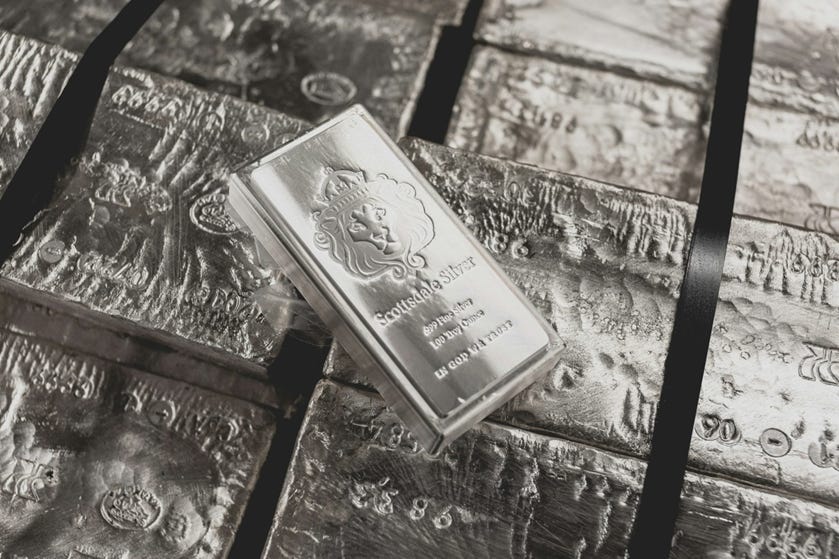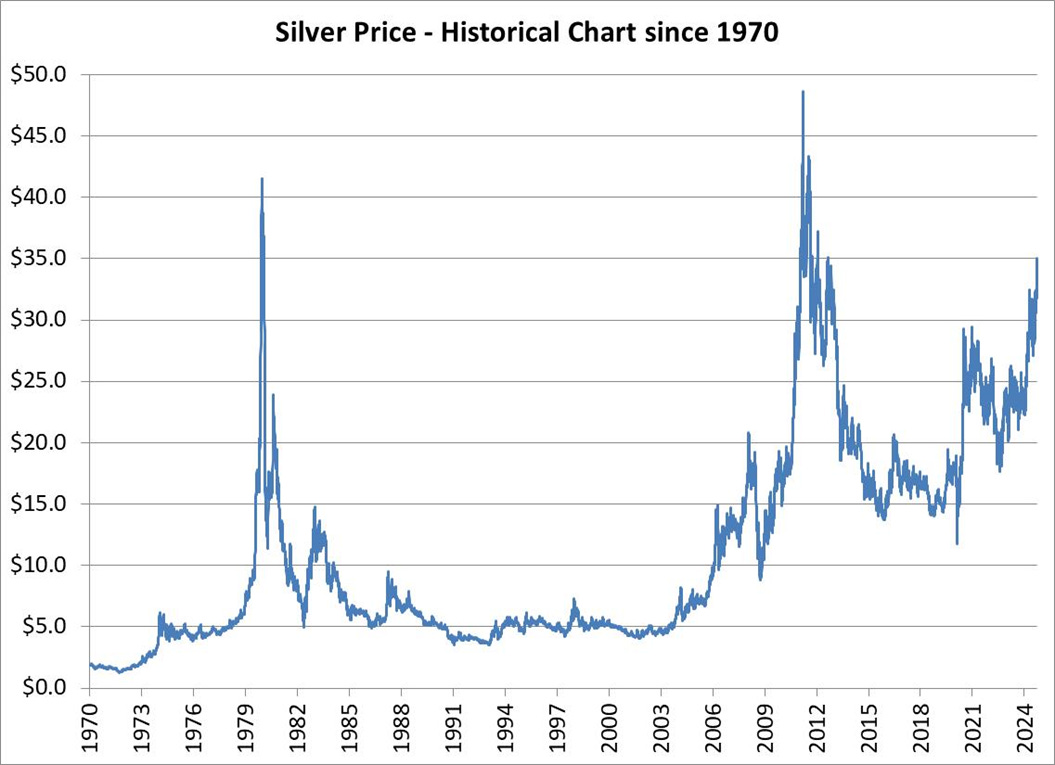The Silver Surge: Investing in Physical Silver ETFs
Get actionable tips for investing in silver
Updated: April 20, 2025
The Case for Investing in Silver
Silver, along with gold, has been used as money and a store of value for thousands of years. Investors often turn to silver in times of inflation to protect their wealth. Unlike paper money which can be printed freely, there is a limited amount of silver available. This characteristic makes it appealing during times of economic uncertainty or high inflation.
Unless you have been living under a rock, you have seen that things are getting more expensive by the day. U.S. debt is now higher than it has ever been, both in dollar terms and as a percentage of GDP. Commodities, especially when they are not overpriced, have historically been the go-to choice for investors looking to protect themselves against the devaluation of paper money.
In my view, silver, next to gold, is currently one such option. Silver though, by historical standards, seems cheaper than gold.
Silver is today (as of November 1, 2024) trading at around $33 per ounce. This is way below its all-time high of around $50 per ounce. Gold, by comparison, is currently trading at a historical high of about $2,800 per ounce. Many investors, including myself, expect gold and silver to rise significantly, but gold is already trading at historical highs, whereas silver is still comparatively cheap.
Legendary investor Jim Rogers has been talking about silver for at least the last two years. He continues to be very bullish on silver.
As recently reported on Morningstar, Rogers said:
“If you were buying one today, you would probably buy silver because it's down from its all-time high, and gold is near its all-time high.”
However, Rogers also mentioned in the article that he owns plenty of both metals. (Source: Morningstar)
In addition, silver is also important for many industries. It is an excellent conductor of electricity and heat, making it vital in electronics manufacturing. Additionally, silver is used in the production of solar panels and batteries. As global demand for renewable energy sources and electric cars increases, so does the demand for silver. This is another reason I favor silver: it has practical industrial applications.
Why Physical Silver ETFs are Interesting
One way to invest in silver is to buy it in physical form like silver coins or silver bars. That way, you get something real that you can hold in your hands. This can feel very rewarding. However, it also means you have to think about where to store it safely. If you don't have a secure place to keep your silver, there’s a risk that it could be stolen. Transporting such physical commodities is also not easy. This is why many people look for alternatives like Physical Silver ETFs.
Physical Silver ETFs are special types of investment funds that allow you to invest in silver without having to physically own it. Instead of keeping silver bars or coins at home, you buy shares in the ETF. The ETF then uses your money to buy and store actual silver in secure locations. That, at least, is the theory. In practice, things are a bit more complicated.
With Physical ETFs, two questions are critical to understand.
What do I actually own, and how secure is it?
What is the tax treatment?
It's essential to know exactly what you're getting when you buy shares in a Physical Silver ETF. Some ETFs hold physical silver, which means they have real silver stored away. Someone is storing the silver. Do you trust that someone? But others might not hold any physical silver at all; they could be investing in contracts or other financial instruments that are linked to the price of silver.
And then, of course, there is the tax treatment. The base assumption would be “Ah, normal capital gain rules—as with ordinary stocks." Unfortunately, that is not correct. If you hold silver ETFs in retirement accounts, that doesn’t matter, but if you hold them in taxable accounts, how you get taxed matters a lot.
Physical Silver ETFs
Physically-backed silver ETFs invest directly in physical silver bullion stored in secure vaults. These funds aim to track the price of silver closely by holding the actual metal rather than derivatives or contracts.
Here is a detailed look at two very popular physically-backed ETFs: iShares Silver Trust (SLV) and Sprott Physical Silver Trust (PSLV).
iShares Silver Trust (SLV)
Sponsor: BlackRock
Fees: 0.50%
Custodian: JPMorgan Chase Bank N.A., London branch
Collateral: The assets of the iShares Silver Trust (SLV) primarily consist of silver held by JPMorgan Chase Bank N.A., London branch. However, there may be situations where the trust unexpectedly holds cash, and it may also hold cash temporarily for operational purposes. SLV does not seem to allow silver lending.
Type: ETF
Structure: Open-ended grantor trust. In simple terms, an open-ended grantor trust is an investment vehicle where investors own shares that represent direct ownership of physical assets held by the trust. It offers liquidity through trading on exchanges while providing pass-through tax treatment, meaning investors are taxed as if they directly own the underlying assets. This structure is commonly used for ETFs that invest in commodities like silver and gold.
US Tax: This is only important if you hold SLV outside of retirement accounts like the 401k, IRA, Roth IRA, etc. For taxable accounts, a commodity-backed ETF is treated by the IRS as a collectible. As such, normal capital gains tax (0%, 15%, and 20%) rates don’t apply. Long-term gains are taxed a flat 28%, irrespective of income level. Short-term gains are taxed as ordinary income, based on your income. If you plan to hold these in a taxable account, double-check with a tax expert to make sure you understand the full impact.
Risks: If you research, there are consistent rumors and concerns regarding its custodian (JPMorgan Chase), issues related to regulatory oversight, transparency, counterparty risk, and potential conflicts of interest. Investors in SLV should carefully consider the concerns surrounding its custodian, especially regarding transparency and risk management, particularly if they seek a secure way to invest in physical silver.
Sprott Physical Silver Trust (PSLV)
Sponsor: Sprott Asset Management
Fees: 0.59%
Custodian: Royal Canadian Mint (RCM)
Collateral: The collateral consists of unencumbered and fully allocated silver bars. These physical silver bars are stored securely by the Royal Canadian Mint (RCM), which acts as the custodian for the trust's assets. PSLV does not seem to allow silver lending. RCM, as a Crown corporation, provides a trustworthy environment, conducting regular audits to maintain transparency. A Crown corporation in Canada is a government-owned entity that operates with a blend of commercial and public policy objectives. In the event of theft or loss of these assets, the RCM has an obligation to compensate for such losses, ensuring that the trust's holdings remain intact.
Type: ETF
Structure: Closed-end trust. A closed-end trust is an investment vehicle that operates similarly to an open-ended grantor trust but with distinct characteristics. In this structure, investors purchase shares that represent a fixed number of units in the trust, which holds physical assets such as commodities or real estate. Unlike open-ended trusts, closed-end trusts do not allow for the continuous issuance or redemption of shares; instead, shares are traded on an exchange, which can lead to price fluctuations based on market demand rather than just the underlying asset value. This can create a premium or discount versus the value of underlying silver.
US Tax: This is only important if you hold PSLV outside of retirement accounts like the 401k, IRA, Roth IRA, etc. For taxable accounts, a commodity-backed ETF is typically treated by the IRS as a collectible, as explained for the iShares Silver Trust (SLV). That is true for PSLV as well. However, PSLV is classified as a Passive Foreign Investment Corporation (PFIC) by the IRS. That allows for long-term capital gains to be taxed at 15% or 20% if a Qualifying Electing Fund (QEF) election is made by filing IRS Form 8621. That has its own complexity and should be properly understood. Short-term gains are taxed as ordinary income, based on your income. If you plan to hold these in a taxable account, double-check with a tax expert to make sure you understand the full impact. The US PFIC tax can increase your tax liability on foreign stock gains (including those purchased on US stock exchanges) from a maximum of 20% for long-term capital gains tax, to over 50% in total. It is easily avoided if you plan ahead, but very expensive if you don’t. You can read about it here.
Risks: Due to its structure (closed-end trust), PSLV shares may trade at a premium or discount to their net asset value (NAV). As of recent data, the premium/discount range has fluctuated, which can affect returns if investors buy at a high premium or sell at a low discount. There are many websites that track the premium/discount, of PSLV including YCharts.com (https://ycharts.com/companies/PSLV/discount_or_premium_to_nav). Investors in PSLV should carefully consider the premium/discount impact.
Summary
In times of inflation, investing in commodities has been one way to protect the value of your money. Silver, currently priced significantly below its all-time high, is a good option to consider. If you want to avoid holding physical silver on your own, silver ETFs may be a good option.
The two popular silver EFTs are iShares Silver Trust (SLV) and Sprott Physical Silver Trust (PSLV).
PSLV has a higher expense ratio of 0.59% compared to SLV's 0.50%. The legal structure of PSLV can result in premiums or discounts relative to its underlying silver net asset value, a situation that occurs less frequently with SLV.
On the other hand, some investors, including myself, favor PSLV because its silver is stored at the Royal Canadian Mint, which is viewed as a more reliable custodian than JPMorgan (the custodian for SLV), especially given JPMorgan's past legal troubles concerning precious metals manipulation.
In the long run, in my view, if silver prices go up significantly along with inflation or even exceed inflation, the very slightly higher expense ratio (versus SLV) or any discount relative to the underlying silver value will not matter, given the corresponding appreciation of PSLV, and (hopefully) because the silver is actually in the vault at the custodian! Nothing would be worse than silver prices exploding and finding out there was a silver storage problem with SLV. I am not saying that there is, but the silver storage for PSLV seems very superior.
For US taxes, if you plan on investing from a taxable account (non-retirement account), you should be aware that the U.S. tax treatment for these ETFs differs from standard ETF tax regulations, and should consult with a tax professional before investing.
Thank you for reading the article. Hope you enjoyed it.
Hungry for more? Subscribe to the newsletter - it's free and fabulous.Enjoyed this article? Don't keep it to yourself! Share it with a friend or two. It's free, and they might even buy you a coffee as a thank you.Your Fringe Finance
Disclaimer
Neither the author nor Fringe Finance is a financial advisor or a tax professional. This article is for illustrative and educational purposes only and does not constitute a specific offer of any product or service.
Past performance of stocks and assets is not an indicator or guarantee of future performance of stocks and assets.
The information in this blog does not constitute an offer to buy or sell, or a solicitation of an offer to buy or sell, any of the securities mentioned herein.
We believe the information provided is accurate and current. However, we do not guarantee its accuracy and it should not be considered a complete analysis of the topics discussed.
Any opinions expressed reflect the author's judgment at the time of publication and are subject to change.
Seek guidance from qualified financial and tax experts before taking action.





